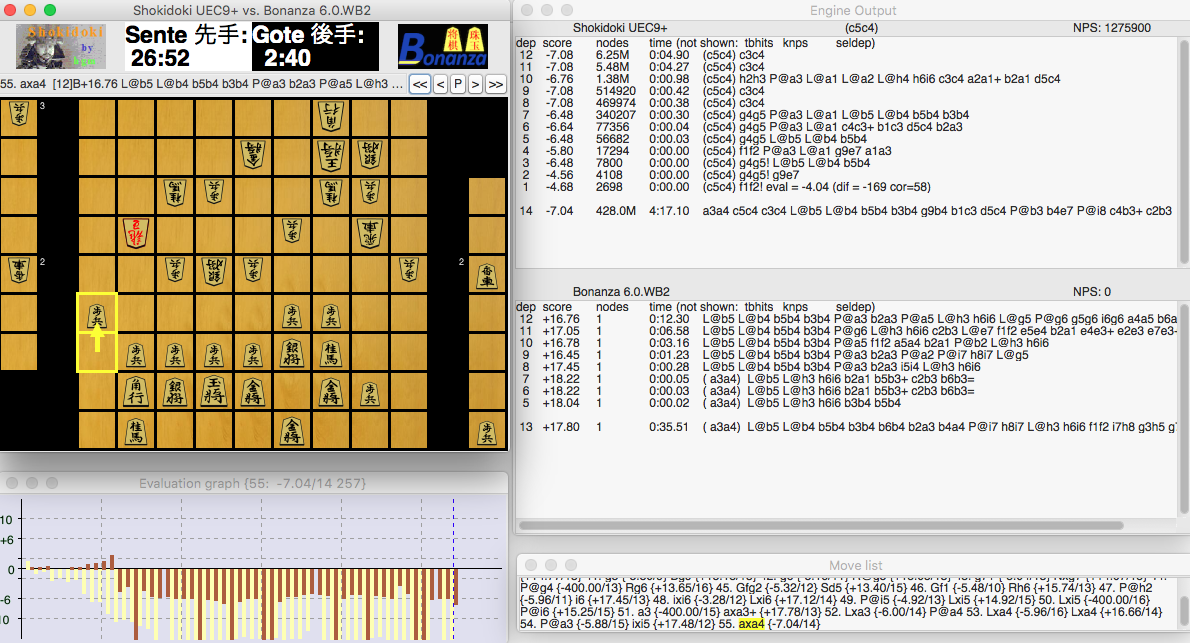|
Yasuaki Murayama
is a Japanese professional shogi player, ranked 7-dan. Early life Yasuaki Murayama was born on May 9, 1984, in Hino, Tokyo. He learned how to play shogi from his grandfather when he was 5 years old, and won the 20th in 1995. Murayama was accepted into the Japan Shogi Association's apprentice school at the rank of 6-kyū as a protegee of shogi professional in September 1995 and was promoted to the rank of 1-dan in July 1998. Murayama obtained full professional status and the rank of 4-dan in October 2003 for winning the 33rd 3-dan League (April 2003September 2003) with a record of 15 wins and 3 losses. Shogi professional Murayama won his first tournament as a professional in October 2007 when he defeated Ryōsuke Nakamura 2 games to none to win the 38th title. In March 2016, Murayama defeated Shōta Chida to win the 65th NHK Cup Shogi TV Tournament. In 2015, Murayama was one of five shogi professional selected to play a match against the five top shogi computers in the ... [...More Info...] [...Related Items...] OR: [Wikipedia] [Google] [Baidu] |
Hino, Tokyo
250px, Takahata Fudō in Hino is a city located in the western portion of Tokyo Metropolis, Japan. , the city had an estimated population of 187,048, and a population density of 6800 persons per km². The total area of the city was . Geography Hino is in Western Tokyo. The city has three geographical regions. The western part is called the Hino plateau, approximately 100 meters above sea level. The southern part is Tama Hills, between 150 and 200 meters above sea level. The eastern part of the city is an alluvial plain of the Tama River. Surrounding municipalities Tokyo Metropolis * Fuchū *Kunitachi *Tachikawa *Akishima *Hachiōji * Tama Climate Hino has a Humid subtropical climate (Köppen ''Cfa'') characterized by warm summers and cool winters with light to no snowfall. The average annual temperature in Hino is 13.9 °C. The average annual rainfall is 1647 mm with September as the wettest month. The temperatures are highest on average in August, at around 25.4&nb ... [...More Info...] [...Related Items...] OR: [Wikipedia] [Google] [Baidu] |
Professional Shogi Players
A professional shogi player (将棋棋士 ''shōgi kishi'' or プロ棋士 ''puro kishi'' "professional player") is a shogi player who is usually a member of a professional guild of shogi players. There are two categories of professional players: regular professional and women's professional. All regular professional shogi players are members of the Japan Shogi Association (JSA). However, only regular professional players, who are all male, are considered to be full-fledged members. Women's professional players belong to groups distinct from regular professional players. In Japanese, the term 棋士 ''kishi'' only refers to regular professional players to the exclusion of women's professionals, who are termed 女流棋士 ''joryū kishi.'' History During the Edo period (1603-1868), shogi followed an iemoto system centered around three families (schools): the , the and the . Titles such as Meijin were hereditary and could only be held by members of these three families. These ... [...More Info...] [...Related Items...] OR: [Wikipedia] [Google] [Baidu] |
People From Hino, Tokyo
A person ( : people) is a being that has certain capacities or attributes such as reason, morality, consciousness or self-consciousness, and being a part of a culturally established form of social relations such as kinship, ownership of property, or legal responsibility. The defining features of personhood and, consequently, what makes a person count as a person, differ widely among cultures and contexts. In addition to the question of personhood, of what makes a being count as a person to begin with, there are further questions about personal identity and self: both about what makes any particular person that particular person instead of another, and about what makes a person at one time the same person as they were or will be at another time despite any intervening changes. The plural form "people" is often used to refer to an entire nation or ethnic group (as in "a people"), and this was the original meaning of the word; it subsequently acquired its use as a plural form of per ... [...More Info...] [...Related Items...] OR: [Wikipedia] [Google] [Baidu] |
Living People
Related categories * :Year of birth missing (living people) / :Year of birth unknown * :Date of birth missing (living people) / :Date of birth unknown * :Place of birth missing (living people) / :Place of birth unknown * :Year of death missing / :Year of death unknown * :Date of death missing / :Date of death unknown * :Place of death missing / :Place of death unknown * :Missing middle or first names See also * :Dead people * :Template:L, which generates this category or death years, and birth year and sort keys. : {{DEFAULTSORT:Living people 21st-century people People by status ... [...More Info...] [...Related Items...] OR: [Wikipedia] [Google] [Baidu] |
Japanese Shogi Players
Japanese may refer to: * Something from or related to Japan, an island country in East Asia * Japanese language, spoken mainly in Japan * Japanese people, the ethnic group that identifies with Japan through ancestry or culture ** Japanese diaspora, Japanese emigrants and their descendants around the world * Japanese citizens, nationals of Japan under Japanese nationality law ** Foreign-born Japanese, naturalized citizens of Japan * Japanese writing system, consisting of kanji and kana * Japanese cuisine, the food and food culture of Japan See also * List of Japanese people * * Japonica (other) * Japonicum * Japonicus * Japanese studies Japanese studies (Japanese: ) or Japan studies (sometimes Japanology in Europe), is a sub-field of area studies or East Asian studies involved in social sciences and humanities research on Japan. It incorporates fields such as the study of Japanese ... {{disambiguation Language and nationality disambiguation pages ... [...More Info...] [...Related Items...] OR: [Wikipedia] [Google] [Baidu] |
1984 Births
Events January * January 1 – The Bornean Sultanate of Brunei gains full independence from the United Kingdom, having become a British protectorate in 1888. * January 7 – Brunei becomes the sixth member of the Association of Southeast Asian Nations (ASEAN). * January 10 ** The United States and the Vatican (Holy See) restore full diplomatic relations. ** The Victoria Agreement is signed, institutionalising the Indian Ocean Commission. *January 24 – Steve Jobs launches the Macintosh personal computer in the United States. February * February 3 ** Dr. John Buster and the research team at Harbor–UCLA Medical Center announce history's first embryo transfer from one woman to another, resulting in a live birth. ** STS-41-B: Space Shuttle ''Challenger'' is launched on the 10th Space Shuttle mission. * February 7 – Astronauts Bruce McCandless II and Robert L. Stewart make the first untethered space walk. * February 8– 19 – The 1984 Winter Olympics are held i ... [...More Info...] [...Related Items...] OR: [Wikipedia] [Google] [Baidu] |
Annual Shogi Awards
The Annual Shogi Awards (将棋大賞 ''shōgi taishō'') are a number of prizes awarded yearly by the Japan Shogi Association to professional and amateur shogi players who have achieved particular success. The first Annual Shogi Awards were presented in 1974. Winners Below is a table of the awards given and the award winners for each year. Kōzō Masuda Awards The Kōzō Masuda Award (升田幸三賞 ''Masuda Kōzō shō'') and the Kōzō Masuda Special Prize (升田幸三賞特別賞 ''Masuda Kōzō shō takubetsu shō'') are two prizes awarded to professional or amateur players who have made an outstanding contribution to the development and evolution of shogi openings by way of innovation or excellence in shogi theory or tactics. The awards are named after the innovative player, Kōzō Masuda. The Masuda Award is given out yearly since 1995 while the Masuda Special Prize is awarded infrequently. Winners Masuda Award * 1995 (22nd Annual Shogi Awards) Kunio Naitō for the S ... [...More Info...] [...Related Items...] OR: [Wikipedia] [Google] [Baidu] |
List Of Shogi Software
This is a list of shogi software (engines and/or Graphical User Interfaces): GUIs * 激指 (Gekisashi) * 将棋所 ( Shogidokoro) * ShogiGUI * 将棋ぶらうざQ (Shogi Browser Q) * XBoard Engines * AlphaZeroNot commercially available. * Apery ** Ukamuse (浮かむ瀬 – the 2016 release of Apery) * BlunderXX * Bonanza * elmo * Gikou (技巧) * GNUShogi * GPS Shogi * Honey Waffle * Laramie * Lesserkai * Lightning * nozomi * Ponanza * Ponanza Quartet * Qhapaq ** aperypaq (Apery SDT5 with Qhapaq learning) ** eloqhappa (elmo WCSC27 with Qhapaq learning) * relmo (elmo WCSC27 + rezero8), * rezero * Silent Majority * Spear * SSP * Tanuki (ナイツ・オブ・タヌキ WCSC27, 平成将棋合戦ぽんぽこ SDT5) * TJshogi * YaneuraOu (やねうら王) * Yomita (読み太) See also * Computer shogi * List of chess software * List of shogi video games References {{reflist, colwidth=30em External links 将棋フリーソフト· shogi engine rating site Shog ... [...More Info...] [...Related Items...] OR: [Wikipedia] [Google] [Baidu] |
NHK Cup (shogi)
The NHK Cup, or as it is officially known the is a professional shogi tournament organized by the Japan Shogi Association and sponsored by Japan's public broadcaster NHK. History Formerly known as the , the 1st NHK Cup was held in 1951 with eight professional shogi players. The winner was Yoshio Kimura, who held the Meijin title at the time. Prior to 1962, the tournament was broadcast only on the radio, but starting with the 12th NHK Cup (1962), the tournament moved to television. The 26th NHK Cup (1976) was the first to be broadcast in color. Up until and including the 15th NHK Cup (1965), only Class A professionals were allowed to participate. When the number of players was increased from 8 to 16 for the 16th NHK Cup (1966), the tournament became open to other professionals as well. The number of players was increased again from 16 to 26 for the 27th NHK Cup (1977) and to its current level of 50 for the 31st NHK Cup (1981). In addition, the preliminary tournaments also star ... [...More Info...] [...Related Items...] OR: [Wikipedia] [Google] [Baidu] |
Dan (rank)
The ranking system is used by many Japanese, Okinawan, Korean, and other martial art organizations to indicate the level of a person's ability within a given system. Used as a ranking system to quantify skill level in a specific domain, it was originally used at a Go school during the Edo period. It is now also used in most modern Japanese fine and martial arts. Martial arts writer Takao Nakaya claims that this dan system was first applied to martial arts in Japan by Kanō Jigorō (1860–1938), the founder of judo, in 1883, and later introduced to other East Asian countries. In the modern Japanese martial arts, holders of dan ranks often wear a black belt; those of higher rank may also wear either red-and-white or red belts depending on the style. Dan ranks are also given for strategic board games such as Go, Japanese chess ('' shōgi''), and renju, as well as for other arts such as the tea ceremony (''sadō'' or ''chadō''), flower arrangement (''ikebana''), Japanese call ... [...More Info...] [...Related Items...] OR: [Wikipedia] [Google] [Baidu] |


_1938.jpg)

